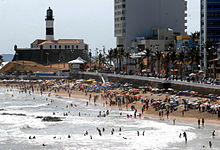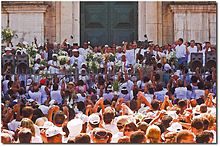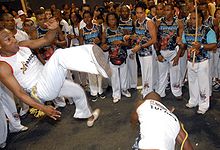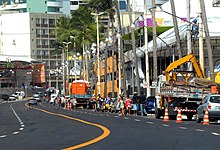| Revision as of 01:52, 8 July 2008 edit189.104.19.56 (talk)No edit summary← Previous edit | Revision as of 15:56, 9 July 2008 edit undoOpinoso (talk | contribs)7,395 edits Undid revision 224265401 by 189.104.19.56 (talk)Next edit → | ||
| Line 40: | Line 40: | ||
| }} | }} | ||
| '''Bahia''' ({{pronounced|baˈi.a}}<ref>In ]. In ] the pronunciation is {{IPA|}}. The H is not pronounced, and the stress is on the ''i.''</ref>) is one of the 26 ], and is located in the northeastern part of the country on the ] coast. It is the fourth most populous Brazilian state after ], ] and ], and the fifth-largest in size. |
'''Bahia''' ({{pronounced|baˈi.a}}<ref>In ]. In ] the pronunciation is {{IPA|}}. The H is not pronounced, and the stress is on the ''i.''</ref>) is one of the 26 ], and is located in the northeastern part of the country on the ] coast. It is the fourth most populous Brazilian state after ], ] and ], and the fifth-largest in size. It is also one of the most important states in terms of history and culture, in Brazil's, and it's only comparable to ] in Brazilian's ]. Bahia's capital is the city of ], or more properly, São Salvador da Bahia de Todos os Santos, that is located at the junction of the ] and the ]. The name is an archaic spelling of the Portuguese word meaning "bay" and comes from "a baía de Todos os Santos" (All Saints' Bay), first seen by European sailors on ] ], ]. | ||
| == Geography == | == Geography == | ||
Revision as of 15:56, 9 July 2008
For other uses, see Bahia (disambiguation).Template:Infobox Brazilian State
Bahia (baˈi.a) is one of the 26 states of Brazil, and is located in the northeastern part of the country on the Atlantic coast. It is the fourth most populous Brazilian state after São Paulo, Minas Gerais and Rio de Janeiro, and the fifth-largest in size. It is also one of the most important states in terms of history and culture, in Brazil's, and it's only comparable to Pernambuco in Brazilian's Northeast Region. Bahia's capital is the city of Salvador, or more properly, São Salvador da Bahia de Todos os Santos, that is located at the junction of the Atlantic Ocean and the Bay of All Saints. The name is an archaic spelling of the Portuguese word meaning "bay" and comes from "a baía de Todos os Santos" (All Saints' Bay), first seen by European sailors on November 1 1501, All Saints' Day.
Geography
The state's geographical regions comprise the Atlantic Forest or mata atlântica; the recôncavo region radiating from the Bay (the largest in Brazil), the site of sugar and tobacco cultivation; and the planalto, which includes the fabled sertão region of Bahia's far interior.

Bahia is bordered, in counterclockwise fashion, by Sergipe, Alagoas, Pernambuco and Piauí to the north, Goiás and Tocantins to the west, and Minas Gerais and Espírito Santo to the south.
The São Francisco River, Brazil's second longest river system, runs from the Atlantic Ocean along the state's northern border with Sergipe and Pernambuco down through the planalto into the neighboring southern state of Minas Gerais.
The state has the longest coastline in Brazil; the northern coastline running from Salvador forms the Linha Verde (Green Line).
Bahia contains the longest known cave in the Southern hemisphere, Toca da Boa Vista, which has 84 km (52 mi) of mapped passages.
History

The Portuguese Pedro Álvares Cabral landed at what is now Porto Seguro, on the southern coast of Bahia in 1500, and claimed the territory for Portugal. In 1549, Portugal established the city of Salvador, on a hill facing the Bay of All Saints. The city and surrounding captaincy served as the administrative and religious capital of Portugal's colonies in the Americas until 1763. The Dutch held control of Bahia from May 1624 through April 1625. Charles Darwin visited Bahia in 1832 on his famous Voyage of The Beagle.
The state was also the last area of Brazil to join the independent confederation. Some members in the elite remained loyal to the Portuguese crown after the rest of the country was granted independence. After several battles, mostly in Pirajá, the province was finally able to expel the Portuguese on July 2, 1823, known as Bahia Independence Day, a great popular celebration. In the state there is an ongoing discussion about the exact moment of Brazilian independence, because for almost all "baianos," it really happened in Bahia with the battles, and not on September 7, when the Emperor, Pedro I, declared independence.

Bahia was a center of sugar cultivation from the 16th to the 18th centuries, and contains a number of historic towns, such as Cachoeira, dating from this era. Integral to the sugar economy was the importation of a vast number of African slaves; more than 37% of all slaves taken from Africa were sent to Brazil, mostly to be processed in Bahia before being sent to work in plantations elsewhere in the country.
The oldest Roman Catholic cathedral and the first medical college in the country are located in Bahia's capital, which also has one of the highest percentage of churches of any state capital in Brazil. The Catholic Archbishop of São Salvador da Bahia, Geraldo Majella Agnelo, is the Cardinal Primate of Brazil.
Also see Misplaced Pages articles and respective discussions:
Demographics

According to the IBGE of 2007, there are 13,974,000 people residing in the state. The population density is 24.7 inh./km².
Urbanization: 67.4% (2006); Population growth: 1.1% (1991-2000); Houses: 3,826,000 (2006).
The last PNAD (National Research for Sample of Domiciles) census revealed the following numbers: 8,831,000 Brown (mixed) people (63.2%), 2,864,000 White people (20.5%), 2,193,000 Black people (15.7%), 83,000 Asian or Amerindian people (0.6%).
Most of the population are in part descendants of Black African slaves, who were mainly Yoruba speakers from Nigeria, Ghana, Togo and Benin.
Interesting facts
| This article contains a list of miscellaneous information. Please relocate any relevant information into other sections or articles. (April 2008) |
Vehicles: 1,461,633 (March/2007); Mobile phones: 5.5 million (April/2007); Telephones: 2 million (April/2007); Cities: 417 (2007). Salvador's Carnival is the biggest of the world.
Economy
The industrial sector is the largest component of GDP at 48.5%, followed by the service sector at 40.8%. Agriculture represents 10.7% of GDP (2004). Bahia exports: chemicals 22.4%, fuel 17.5%, mineral metallics 13%, paper 9.4%, cacao 5.6%, vehicles 4.8%, soybean 4.5% (2002).

Share of the Brazilian economy: 4.9% (2004).
The state has the biggest GDP of the states of the North/Northeast of Brazil. Bahia is the main producer and exporter of cacao in Brazil. In addition to important agricultural and industrial sectors, the state also has considerable mineral and petroleum deposits. In recent years, soy cultivation has increased substantially in the state.
- Chemical and Petrochemical
Bahia's Petrochemical Pole is the largest integrated complex in the Southern Hemisphere, and is the result of R$10 billion in investments, accounting for a third of the state's exports and for nearly half of the industrial production value.
- Mining

Bahia is one of the richest states in minerals in the country, ranking third in Brazilian mineral production. The State's main products are gold, copper concentrate, magnesite, chromite, rock salt, barite, manganese, ornamental rocks, precious stones, talcum, phosphates and uranium.
- Automotive
In Bahia, the automotive sector has gained prominence since the creation of the Northeast Ford Complex in Camaçari (2001), and has become one of the most promising sectors of the Bahian economy. This enterprise, which was developed with the aim of generating 5,000 direct jobs and 55,000 indirect ones in 2005 has surpassed those expectations by creating 8,500 direct job positions and 85,000 indirect ones since its development.
Nowadays, Bahia produces about 10% of all vehicles produced in Brazil, occupying the third position in the national rankings. The Bahian automotive sector, led by Ford was in 2005 the third largest contributor (14.6%) to the Bahian GDP. It is important to highlight that Bahia had a 4.8% overall increase in its GDP, double the national performance, according to the Superintendency of Economic and Social Studies of Bahia (SEI)/Secretariat of Planning and IBGE.

- Other Market Segments:
Agribusiness; Footwear; Call Centers; Informatics, Electronics, and Telecommunications; Nautical; Paper and Pulp; Textiles; Plastic Transformation; and Tourism.
Tourism: Bahia's long coastline, beautiful beaches and cultural treasures make it one of Brazil's chief tourist destinations. In addition to the island of Itaparica, the town of Morro de São Paulo across the Bay on the northernmost tip of the southern coastline, and the large number of beaches between Ilhéus and Porto Seguro, on the southeastern coast, the littoral area north of Salvador, stretching towards the border with Sergipe, has become an important tourist destination. The Costa do Sauípe contains one of the largest resort hotel developments in Brazil and South America.
Education

Portuguese is the official national language, and thus the primary language taught in schools. But English and Spanish are part of the official high school curriculum.
Educational institutions
- Universidade Federal da Bahia (UFBA) (Federal University of Bahia);
- Universidade Católica de Salvador (UCSal) (Catholic University of Salvador);
- Centro Federal de Educação Tecnológica da Bahia (Cefet-BA);
- Escola Baiana de Medicina e Saúde Pública (EBMSP) (Bahiana School of Medicine and Public Health);
- Universidade Salvador (Unifacs) (Salvador University);
- Universidade Federal do Recôncavo da Bahia (UFRB) (Federal University of Recôncavo da Bahia);
- Universidade Estadual do Sudoeste da Bahia (Uesb) (State University of Southwest of Bahia);
- Universidade Estadual de Santa Cruz (UESC) (State University of Santa Cruz);
- Universidade do Estado da Bahia (Uneb) (University of State of Bahia);
- Universidade Estadual de Feira de Santana (UEFS) (State University of Feira de Santana);
- Fundação Universidade Federal do Vale do São Francisco (UNIVASF) (Foundation Federal University of São Francisco Valley);
- Centro Universitário da Bahia (FIB) (University Centre of Bahia);
- and many others.
Infrastructure
International Airport
Deputado Luís Eduardo Magalhães International Airport is located in an area of more than 6 million square meters between sand dunes and native vegetation. The road route to the airport has already become one of the city’s main scenic attractions. The airport’s use has been growing at an average of 14% a year and now is responsible for more than 30% of passenger movement in Brazil’s Northeast. Nearly 35 thousand people circulate daily through the passenger terminal. The airport generates more than 16 thousand direct and indirect jobs, to serve a daily average of over 10 thousand passengers, 250 takeoffs and landings of 100 domestic and 16 international flights.
In addition to domestic and regional services, the airport has non-stop flights to Lisbon, Madrid, Frankfurt, Montevideo, Santiago, Buenos Aires, Asunción and Miami. Its IATA airport code is SSA and it is the sixth busiest airport in the country, the first in northeastern Brazil, behind Congonhas International, Guarulhos International, Juscelino Kubitschek International, Santos Dumont Regional and Galeão International.
Highways

- BR-101,
- BR-116,
- BR-242,
- BR-251,
- BR-324,
- BR-342,
- BR-367,
- BR-407,
- BR-418,
- BR-420,
- BR-445,
- BR-498.
Port
Port of Salvador. With a cargo movement that grows year after year following the same economic development rhythm implemented in the State, the Port of Salvador, located in the Bahia de Todos os Santos, holds the title of port with the highest movement of containers of the North/Northeast and the 2nd major fruit exporter in Brazil. It is in this rhythm, of intense movement that the port of Salvador gets ready for new investments in technologic modernization and of its infrastructure, implementing a higher operational agility and more competitive rates. The goal is to offer the necessary infrastructure for the products to outflow attending the actual needs of the national importers and exporters.
Culture




As the chief locus of the early Brazilian slave trade, Bahia is considered to possess the greatest and most distinctive African imprint, in terms of culture and customs, in Brazil. These include the Yoruba-derived religious system of Candomblé, the martial art of capoeira (especially the style of capoeira de Angola), African-derived music such as samba (especially samba's Bahian precursor samba-de-roda), afoxé, and axé, and a cuisine with strong links to western Africa.
Bahia is the birthplace of many noted Brazilian artists, writers and musicians. Among the noted musical figures born in the state are Dorival Caymmi; João Gilberto; Gilberto Gil, the country's Minister of Culture; Caetano Veloso and his sister Maria Bethânia (Gil and Veloso being the founders of the Tropicália movement (a native adaptation of the hippie movement) of the late 1960s and early 1970s, which ultimate gained international recognition); Gal Costa; Luis Caldas; Sara Jane; Daniela Mercury; Ivete Sangalo; Carlinhos Brown and Margareth Menezes.
The city of Salvador is also home to internationally famous groups known as "blocos-afros," including Olodum, Ara Ketu, É o Tchan, and Ilê Aiyê. Additionally, groups such as Chiclete com Banana also are based in Bahia. The first well-known rock'n roll singer in Brazil was also from Bahia. Born Raul Seixas, he was known as "Maluco Beleza" or "Peaceful Lunatic" (To be "beleza" in this sense means to be either "in peace" or "high").
During the 19th century, one of Brazil's greatest poets, the Bahian abolitionist poet and playwright Castro Alves, a native of the recôncavo city of Cachoeira, penned his most famous poem, Navio negreiro, about slavery; the poem is considered a masterpiece of Brazilian Romanticism and a central anti-slavery text.
Other notable Bahian writers include Gregório de Matos, who wrote during the 17th century and was one of the first Brazilian writers, and Fr. Antonio Vieira, who during the colonial period was one of many authors who contributed to the expansion of the Portuguese language throughout the Brazilian territory.
The major Brazilian fiction writer of the 20th Century, Jorge Amado, was born in the southeastern Bahian city of Itabuna, and resided for many years in Salvador. His major novels include Gabriela, Cinnamon and Cloves; Dona Flor and Her Two Husbands; and Tieta, the Goat Girl, all of which became internationally renowned films. More recent writers from Bahia include the fiction writers João Ubaldo Ribeiro and Jean Wyllys, winner of Big Brother Brasil 5 in 2005.
In the visual and plastic arts, one of the best known Bahian figures was the multigenre artist and Argentinian native Hector Julio Páride Bernabó, also known as Carybé (1911-1997). Fine examples of his work are visible in the Afro-Brazilian Museum in Salvador.
Carnival
Like river rapids, from which no one wants to escape, the 'Trio-Elétricos' sweep up whoever is in Salvador during Carnival. The 'Trio-Elétricos' -- floats with amplifiers used as moving stages -- pass through three official circuits. Behind them, more than 2 million merrymakers dance along 25 km of streets and avenues. Osmar’s float goes from Campo Grande to Castro Alves square, in the town centre; Dodô’s float, goes from Farol da Barra to Ondina, along the coast; and Batatinha’s float goes across the Pelourinho. The first is the oldest circuit. It is also where the event’s most traditional groups parade. In the Dodô circuit, where the more famous artists’ box seats are located, the party becomes lively toward the end of the afternoon, and it continues like this until morning.
Sports
Soccer is the most popular sport. The two most popular soccer teams are Esporte Clube Bahia (Bahia Sport Club) and Esporte Clube Vitoria (Victory Sport Club). In 2007, Bahia plays in the Brazilian Serie C, while Vitoria plays in the Brazilian Serie B. Bahia has won the premier national soccer competition twice: The Taça Brasil in 1959 and the national league (Campeonato Brasileiro) in 1988. Bahia is also one of the original founders of the Clube dos Treze (Club of the Thirteen). Vitoria was the national league runner-up in 1993.
In the sport of boxing, Bahian native Acelino "Popó" Freitas is the current world champion (WBC) in the lightweight class.
Salvador is one of the 18 remaining candidates to host games of the 2014 FIFA World Cup, for which Brazil is the only South American bidder.
Other Important Cities

Beyond the capital, other important cities in the state include: the old island city of Itaparica, on the island of the same name, in the Bay of All Saints; the industrial city of Camaçari in the Salvador region, with the biggest petrochemical pool in Latin America; the reconcôncavo cities of Cachoeira, Santo Amaro, Nazaré, and São Félix; the resort towns of Arembepe and Conde on the north coast; Ilhéus, where Jorge Amado spent his childhood, and nearby Itabuna; the resort town of Morro de São Paulo, in the Valença region; the southern coastal cities of Porto Seguro, now a major tourist destination, Santa Cruz Cabrália, and Prado; Juazeiro, the twin city of Petrolina in Pernambuco, on the São Francisco River; Feira de Santana e Serrinha in the north; Jequié; Ipiaú; Vitória da Conquista, in the southeast part state; and Lençóis and Palmeiras, in the Chapada Diamantina region.
Famous Bahians/Baianos
Baianos, as natives and residents of Bahia are popularly called in Brazil, have made extensive contributions to Brazilian history, culture, music, literature, education, science, and technology. Some important contemporary Bahians include:
- Raimundo Sodré, singer/composer noted for his adherence to traditional Bahian musical forms such as samba-de-roda, and traditional forms of Brazil's Nordeste, such as the baião.
- Maria Bethânia, singer, sister of Caetano Veloso
- Carlinhos Brown, composer, percussionist, singer, and member of Timbalada and Tribalistas
- Luis Caldas, singer
- Gal Costa, singer
- Elomar Figueira de Mello, composer, and singer
- Dida, internationally-acclaimed football goalkeeper
- Acelino "Popó" Freitas, WBC champion
- Gilberto Gil, singer, composer, environmentalist and Brazilian Minister of Culture (2003-); founded the musical movement Tropicália with Caetano Veloso
- João Gilberto, singer and composer, considered with Tom Jobim (Antonio Carlos Jobim) as one of the founders of bossa nova

- Adriana Lima, fashion model and Victoria's Secret Angel
- Goya Lopes, fashion designer
- Margareth Menezes, singer
- Daniela Mercury, singer
- Luiz R. B. Mott, anthropologist, leading gay rights activist, and founder of Grupo Gay da Bahia, the oldest LGBT and human rights groups in Brazil
- Ivete Sangalo, singer
- Pitty, rock/hardcore singer.
- Caetano Veloso, singer, composer, activist, and author, founded the musical movement Tropicália with Gilberto Gil
- Tom Zé (Antônio José Santana Martins), singer-songwriter, member of the Tropicália movement
- Raul Seixas, rock singer-songwriter
- Glauber Rocha, filmmaker, writer and actor
References
- In Brazilian Portuguese. In European Portuguese the pronunciation is . The H is not pronounced, and the stress is on the i.
- Source: PNAD.
- Síntese de Indicadores Sociais 2007 (PDF) (in Portuguese). Bahia, Brazil: IBGE. 2007. ISBN 85-240-3919-1. Retrieved 2007-07-18.
- Introduction to Bahia - New York Times
- Source: IBGE.
- Salvador's Carnival (PDF) (in Portuguese). Bahia, Brazil: Rank Brasil. 2006. ISBN 85-240-3919-1. Retrieved 2007-07-18.
- List of Brazilian states by GDP (PDF) (in Portuguese). Bahia, Brazil: IBGE. 2004. ISBN 85-240-3919-1. Retrieved 2007-07-18.
External links
- Template:Pt icon Official Website
- Template:En icon Brazilian Tourism Portal
- Template:En icon Bahia-Online.net
| Brazil articles | |||||||
|---|---|---|---|---|---|---|---|
| History | |||||||
| Geography | |||||||
| Politics | |||||||
| Economy |
| ||||||
| Society |
| ||||||
| |||||||||||||||||||||||||||||||||||||||||||||||||||
| Related topics | |||||||||||||||||||||||||||||||||||||||||||||||||||
| Regions and states of Brazil | |||||||||||
|---|---|---|---|---|---|---|---|---|---|---|---|
| Federative units |
| ||||||||||
| Notable archipelagos | |||||||||||
| Socio-geographic divisions | |||||||||||